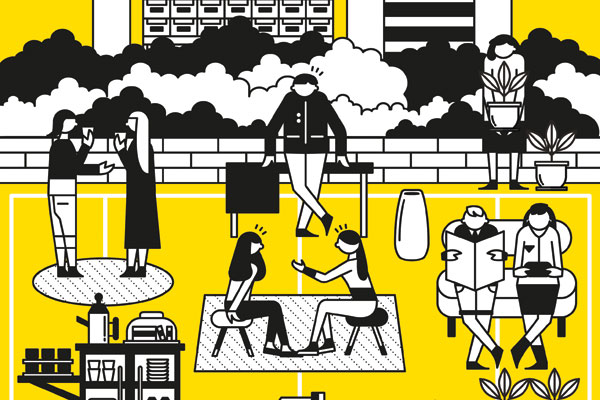Urban advocate Adib Jalal talks about giving a bit of soul to our spaces.

February 4th, 2015
Illustration: Ella Tay
During my formal education in architecture school, I was taught to learn how to read and manipulate the formal design languages of geometry and tectonics. In the academic studio, we spoke about materiality and ephemerality, skin and structure, and were told to ground it in history, theory and context. We were assessed on spatial quality and aesthetics and told that these qualities separated architecture from building.
On most occasions, we were expected to answer the brief and on others, challenge it – and we did. My classmates and I imagined great plazas with impromptu urban life, streets filled with spillover activities, artworks to be discovered at backlanes, and rooftop film screenings. But we would soon discover that not many of these would materialise.
Instead, there were unused pockets of beautiful spaces, human-less lushly landscaped parks and vast roof surfaces as carparks. The renderings with vibrant activities manifested as empty beautiful spaces.
While many have identified creative programming to be key, a lack of contextual relevance of what was proposed and resources to execute the good ones, has often led it to remain as latent spatial potential and many, including myself, have been looking for ways to harness this.
Today, we see acts of urban activation attempting to get closer towards fulfilling the potential of our built spaces. For example, the Experience Market during Archifest 2013 is an attempt to turn an uncharacteristic and lifeless gravel area at Dhoby Ghaut Green into a vibrant marketplace under the canopy. Elsewhere, in the backlanes of Bangsar and Petaling Jaya in Malaysia, community gardens and resident-led parties by the likes of renowned landscape architect Ng Sek San and architect Ms Foo Hui Ping, attempt to bring relevance into these often forgotten but highly intimate spaces. Some ground-up and some empowered by intelligent organisations, projects like these are what reinforce my belief that photogenic spaces are only half the answer to creating a successful piece of architecture or urban space and it is the ability of people to use it meaningfully that makes a difference.
Space on its own, no matter how well made, will always be lifeless until we, the urban citizens, bring our own into it. In a way, the heartbeat of our places is actually ours. When we live our richly complex lives in these spaces and are empowered to participate in it and encouraged to take ownership of it, we tap into this latent spatial potential to make something magical happen, turning a mere space into our own place.
Call it placemaking or urban activation, they point to the same thing – allowing the space to fulfill its potential by imbuing the hardware with some heartware, and perhaps it is time we reconsider our definition of what makes a successful piece of architecture. As Lao Tzu was quoted as saying in The Book of Tea, “The reality of a room, for instance, was to be found in the vacant space enclosed by the roof and the walls, not in the roof and walls themselves. The usefulness of a water pitcher dwelt in the emptiness where water might be put, not in the form of the pitcher or the material of which it was made.”
This article first appeared in Cubes Indesign issue 67
A searchable and comprehensive guide for specifying leading products and their suppliers
Keep up to date with the latest and greatest from our industry BFF's!

In the pursuit of an uplifting synergy between the inner world and the surrounding environment, internationally acclaimed Interior Architect and Designer Lorena Gaxiola transform the vibration of the auspicious number ‘8’ into mesmerising artistry alongside the Feltex design team, brought to you by GH Commercial.

Suitable for applications ranging from schools and retail outlets to computer rooms and X-ray suites, Palettone comes in two varieties and a choice of more than fifty colours.

The Sub-Zero Wolf showrooms in Sydney and Melbourne provide a creative experience unlike any other. Now showcasing all-new product ranges, the showrooms present a unique perspective on the future of kitchens, homes and lifestyles.

Marylou Cafaro’s first trendjournal sparked a powerful, decades-long movement in joinery designs and finishes which eventually saw Australian design develop its independence and characteristic style. Now, polytec offers all-new insights into the future of Australian design.

Buchan’s Andre Jones outlines five factors that will positively impact on the design evolution of Perth. From policy to population, biophilic measures and sense of place. Read Andre’s insights here.

Integrating connectivity, biodiversity, culture and ecology, this pedestrian bridge by the Melbourne-Shanghai-based firm, BAU, is a hybrid public destination for leisure and relaxation.
The internet never sleeps! Here's the stuff you might have missed

Milanese artisan Henry Timi celebrates natural materials through strikingly reduced geometric forms, creating a stripped-back vision of interior luxury.

Wood Marsh’s 40-year legacy shines through landmark infrastructure projects. Recently completing stunning stations at Coburg and Moreland, their designs blend modernity with community needs.